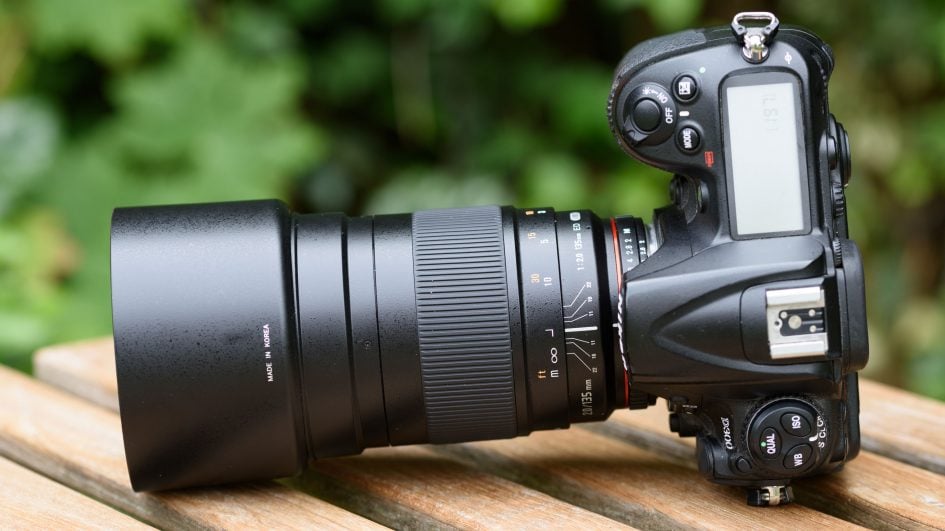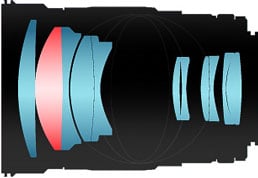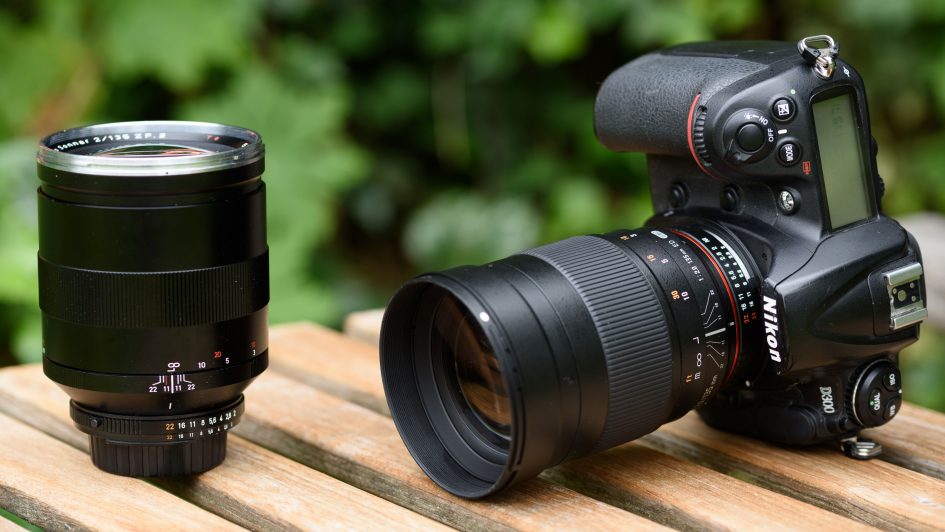Samyang 135mm f2 review
-
-
Written by Thomas
In depth
The Samyang 135mm f2 ED UMC is a medium telephoto lens with a large aperture for full-frame bodies. The relatively low price tag makes it very affordable especially compared to the similarly spec’d Zeiss Apo Sonnar; indeed it’s between a third and a quarter of the price, and like the Zeiss, the Samyang is manual only focus and has no image stabilization.
The Samyang is available for Canon EF, Nikon F (AE), Sony E and A mounts, Fujifilm X, and MFT. Be aware though that the Nikon version is the only one with a chip and an automatic aperture. With the other versions you have to stop down manually before shooting and no EXIF data will be transferred to the camera. The Samyang is also available under the Rokinon and Walimex brands in other regions. In my Samyang 135mm f2.0 review I’ll share my findings, including sharpness results, contra-light performance, Bokeh, and a selection of sample images when mounted on a Nikon D810 body.
PS – don’t forget you can support my work next time you order anything at Amazon, B&H or Adorama by first clicking through to them using the links above and in the sidebar. It works for anything you order at any time – thanks for your support!

Facts from the catalog
As usual I’ll have a look at the technical data of the Samyang (in Nikon ZF.2 version) first. I’ve rated the features with a [+] (or [++]), when it’s better than average or even state of the art, a [0] if it’s standard or just average, and [-] if there’s a disadvantage. For comparison I use the Zeiss Apo Sonnar 135/2.0 (“Zeiss” for short).
Size (diameter x length): 82 x 120 mm. The lens-hood adds another 44mm to the length of the lens. The Zeiss is 15mm shorter w/o lens-hood but a little bulkier at the focus ring. [0]
Weight: 815g. The Zeiss is at little heavier at around 920g. The plastic lens hood adds another 60g to the Samyang while Zeiss’s metal lens hood weighs an additional 100g. [0]

Optics: 11 elements in 7 groups which is similar to the Zeiss. 7 groups have 14 glass/air surfaces which is pretty low for a modern design and reduces the risk of reflections inside the lens. The lens contains one special dispersion elements, hence the “ED” moniker. Both the Samyang and the Zeiss employ no aspheric elements which should be good for the Bokeh as this avoids onion rings. [+]
Closest focus distance is 0.80m which gives you a maximum magnification of 1:4.7. That’s quite useful but a little less than the Zeiss offers at 1:4. The lens does not extend while focusing close. [+]
Filter-thread: 77mm, the professional standard. It’s the same for the Zeiss. [0]
Image stabilization: No. That’s about par for the course on most large aperture primes. Unfortunately at a focal length of 135mm and with today’s high resolution sensors it’s pretty challenging to avoid blur/shake with hand-held shots. Use 1/250 sec to be on the safe(r) side or use a tripod. Tamron has proven that you can build f1.8 primes with image stabilization and not compromise image quality for it. [0]
Auto focus: No! Manual-focus only just like the Zeiss. [-]
Covers full frame/FX or smaller = very good. Same with the competition. [+]
Price: around 500 EUR new (incl. 19% VAT). The Zeiss is much more expensive at 1800 EUR. [+]
A soft lens pouch and a plastic lens hood are included. The hood is reversible for transport and the lens-caps are similar to Nikon’s. [0]
Distance information is not relayed to the camera, the lens delivers a value of 3m regardless of the distance you choose. This disables some of the advanced exposure-related stuff e.g. a Nikon body can do although the lens (only in the Nikon ZF.2 version) does have electrical contacts and communicates some EXIF data with the body. The Zeiss is the same in this respect. [0]
Aperture ring: yes (Nikon ZF.2 version only), so you can control aperture from the lens just like in old times. The aperture ring has half-stop clicks except between f22 and f16. Which is a pity for videographers as they prefer a step-less aperture control. But Samyang offers a cine version of this lens too (the Samyang 135mm T2.2 ED UMC VDSLR Cine Lens) which has the added benefit of an aperture and focus gear ring for mounting on follow focus rigs. There’s no latch at f22 should you prefer to control the aperture from the camera. So the Samyang has the risk of inadvertently moving the aperture ring and making the camera body throw an error message. [+]
Sealing: no rubber-grommet at the lens-mount. Same with the Zeiss. [0]
The score in the “features-department” is 1[-]/7[0]/5[+]. The major minus of the Samyang is its missing autofocus. And at 135mm focal length this is a real critical issue as you have to be very careful with the focus indicator to nail focus at f2.0. But other than that the lens has a lot going for it: it’s cheap, not too big/heavy and offers a nice magnification at 0.8m distance.
Two 135mm f2.0 lenses

Above left: Zeiss 135/2.0 Apo Sonnar, right: Samyang 135mm f2.0 ED UMC
Alternatives:
– Zeiss offers an alternative with their 135/2.0 Apo Sonnar from 2013. It is manual focus only too and costs a whopping 1800 EUR (incl. 19% VAT). It is built like a tank and has an excellent optical quality. See my Zeiss 135mm f2.0 Apo Sonnar review where it earned a Recommended award, but missed out on our top rating due to price.
– From Nikon there’s the venerable AF-S DC 135/2.0D from 1995. It offers autofocus (driven by the camera) and has a unique Defocus-image Control (hence the “DC” moniker) which can be used to change the appearance of out-of-focus areas. It costs around 1300 EUR and is not a bad lens. But it exhibits some very colorful aberrations as can be seen in the comparative shots of my Zeiss 135mm f2.0 Apo Sonnar review. Have a look at the results and you’ll understand why I’d hesitate to recommend this lens.
– Canon users can get the EF 135/2.0 L USM from 1996 which offers autofocus with built-in ultrasonic drive and seems like a very decent performer albeit with very visible longitudinal CAs. It costs around 950 EUR.
– Sony offers the SAL 135/1.8 ZA Carl Zeiss Sonnar T* from 2006 for A-Mount or via adapter also for E-Mount. It has autofocus but relies on the body to provide the AF-drive. It’s around 1500 EUR and is the largest aperture 135mm lens available. Tests indicate that it’s a very good performer albeit with some serious longitudinal CAs.
Focus and build quality
As with every manual focus lens I can only say: if you can’t manage to properly focus manually you better forget about this lens, skip this review to avoid being infected by the superior image quality, and head over to alternative lenses that offer autofocus. Only if you’re shooting from a tripod or your style allows for taking a second or third shot to nail focus then this may be a lens for you. But make no mistake: hand-held focusing in live-view is almost impossible as the long focal length of 135mm magnifies any shake and the image jumps around on the screen at maximum magnification. So you better get some support. Using the focus-indicator of your camera is also quite a gamble unless you know exactly when the lens achieves sharpest focus – and check focus after each shot. But to be honest: Even with all the autofocus lenses I use I almost always check for perfect focus, because with less than ideal targets there’s always a chance the camera pulled focus to a different spot than you intended it to.
The focus ring seems to have no slack/play between its movement and the focus-action and a throw of 200 degrees, which is quite good for accurate focus wide open. The focus ring is easy to grip with a 29mm wide rubber surface but movement feels coarse and it can hardly be operated with one finger. There’s a small range (about 1mm) where the focus ring moves a little easier which feels like slack but focus still follows immediately. The lens has hard stops on both sides of the distance scale so you know exactly when you’ve reached one or the other end of the focus range. But the hard stop on the far end is a bit beyond infinity so you star-gazing photogs still need to find exact focus manually if you want to capture the Milky Way in all its sparkling glory. The distance scale and dof markings are clearly readable and not obscured by a plastic window.
The lens has nine rounded aperture blades. It has a metal lens-mount but other than that feels totally plasticky. The lens hood is not a good fit at the lens-front and does rattle a bit.




